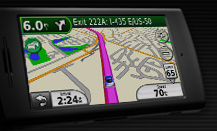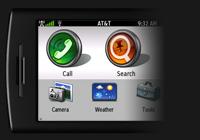Navigation smartphone runs Linux
Feb 12, 2009 — by Eric Brown — from the LinuxDevices Archive — 3 views Garmin and AsusTek (Asus) have announced a jointly developed smartphone that offers Garmin's “Nuvi” location-based services (LBS) features and runs Linux. The Nuvifone G60 offers a 3.5-inch touchscreen, 4GB of flash, GSM and HDSPA connectivity, WiFi, Bluetooth, GPS, and a 3-Mpixel camera with geotagging.
Garmin and AsusTek (Asus) have announced a jointly developed smartphone that offers Garmin's “Nuvi” location-based services (LBS) features and runs Linux. The Nuvifone G60 offers a 3.5-inch touchscreen, 4GB of flash, GSM and HDSPA connectivity, WiFi, Bluetooth, GPS, and a 3-Mpixel camera with geotagging.
(Click for larger view of the Nuvifone G60)
The companies pre-announced the Nuvifone G60 last week, but offered few details on the phones, even omitting mention of the operating systems. In addition to the Linux-driven G60, Garmin and Asus has announced a somewhat similar Nuvifone M20 that runs Windows Mobile.
Garmin and Asus have said they are considering developing an Android version if the Nuvifone, and in fact, have been doing so for awhile, according to several reports. However, the Android phone appears to be postponed until a future release. The companies did not offers details on the G60's Linux implementation, but it may well share some common heritage with the GNOME Mobile distribution that Garmin has used in its high-end, Linux-based Nuvi 8XX series personal navigation devices (PNDs).

Nuvifone G60's Webkit-based browser
While Garmin is bringing its PND/LBS chops to the partnership, Asus brings its long history of developing smartphones, mostly running Windows Mobile. Asus has also had considerable Linux device experience, with its Linux-compatible Asus Eee PC netbooks.
The Nuvifone is billed as being an all-in-one, LBS-centric phone, mobile web-browser, and personal navigator. Garmin did not mention the processor used in the phone, but for the Windows Mobile M20 version it lists a Qualcomm MSM7200A clocked at 528MHz. The phones are fairly similar in specs except in the size of the device and the size and resolution of the screen. The G60 is the larger of the two phones, measuring 4.4 x 2.3 x 0.6 inches, and it offers a larger 3.5-inch accelerometer-driven touchscreen, compared to the M20's 2.8-inch display. On the other hand, the G60's resolution is listed as 272 x 480 whereas the A20 offers a higher 640 x 480 resolution, according to the companies.


Nuvifone in landscape mode
The Nuvifone G60 ships with 128MB RAM and 4GB flash, say Garmin and Asus. The phone provides quad-band GSM cellular, as well as “3.5G” HSDPA support with up to 3.6Mbps downlinks. The G60 is said to offer 802.11b/g WiFi, Bluetooth, and a mini-USB 2.0 port.
Features and specifications listed by Garmin and Asus for the Nuviphone G60 include:
- Processor — not stated
- Memory — 128MB RAM
- Flash — 4GB
- Flash expansion — Micro SD, HC Capable, expandable up to 16GB
- Display — 3.5-inch touchscreen with 272 x 480 resolution, 65K colors
- Camera — 3-megapixel, with autofocus, geo-tagging
- Cellular — Quad-band (850/900/1800/1900MHz) GSM GSM/GPRS/Edge; Tri-band 850/1900/2100MHz HSDPA with 3.6Mbps downlinks
- Bluetooth — Bluetooth 2.0 with AVRCP
- GPS — GPS with Garmin Nuvi nav capabilities
- USB — A2DP mini-USB 2.0
- Other connectivity — HFP (hands-free protocol); HSP
- Audio — MP3 capable
- Headphone jack — 2.5mm
- Web and email — Webkit HTML browser; POP3, IMAP 4, IMAP idle, and SMTP email
- PIM — Outlook contacts and calendar
- Document formats — Word, Excel, PowerPoint, PDF, JPG
- Battery — 1100mAh removable lithium-ion battery
- Dimensions — 4.4 x 2.3 x 0.6 (112 x 58.1 x 14.6mm)
- Weight, including battery — 4.8 oz (137 gr)
- Operating system — Linux
A location-based interface
The Nuvifone interface features three primary icons — Call, Search, and View Map — with secondary icons arranged along the side. An onscreen QWERTY keyboard is also offered. Users can scroll through the icons with the swipe of a finger, and flipping the phone automatically adjusts between portrait and landscape orientations, say the companies.
The G60's GPS-driven navigation system “operates like a Garmin Nuvi PND,” say the companies, and location information is also integrated in the phone's email, SMS, and photo sharing apps. The Nuvifone provides turn-by-turn and voice-prompted navigation, preloaded maps, millions of points of interest, and search by street address, name, or category. The Nuvifone is also said to offer Internet-enabled local search, as well as Garmin's “Ciao!” social networking application, which “bridges the gap between multiple location-based social networks and integrates them.”
Additional Nuvifone features are said to include traffic and weather alerts, as well as flight status. It even offers proximity alerts notifying drivers of “upcoming safety cameras” — helping European drivers avoid speeding tickets.
Geotagging with the Nuvifone
One of the more intriguing features is the geo-tagged photo capability. The 3-Mpixel auto-focus camera automatically geotags images with latitude and longitude references. Users can then navigate back to a location based on the image, or email the geo-tagged image to others. The phone also provides access to millions of geo-located landmark and sightseeing photographs available through Google's Panoramio picture sharing site.
For safety purposes, selecting “Where am I?” provides exact latitude and longitude coordinates, nearest address, intersection, hospital, police station and gas station. All of this can be instantly transmitted along with a phone call, says Garmin and Asus. To help find parked cars, the G60 can also automatically mark the position of the phone when it was last removed from the windshield mount, say the companies.
Availability
Garmin and Asus say they will announce pricing and availability for the Nuvifone G60 when it ships in the first half of 2009. The Nuvifone G60 and Nuvifone M20 will be on display at next week's Mobile World Congress (MWC) in Barcelona, in Hall 7, stand #7C37.
hr>
This article was originally published on LinuxDevices.com and has been donated to the open source community by QuinStreet Inc. Please visit LinuxToday.com for up-to-date news and articles about Linux and open source.